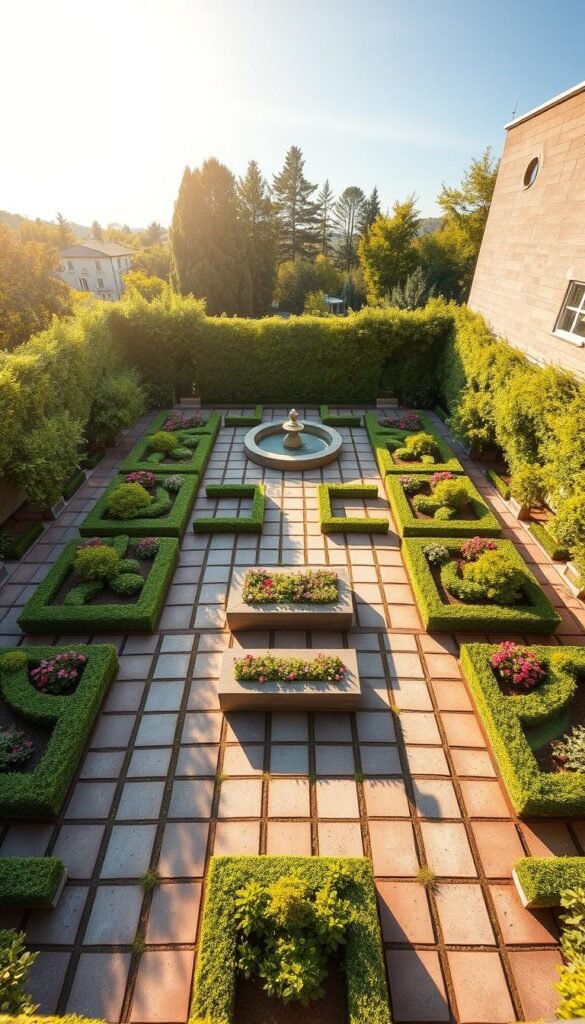Do you think small outdoor areas can’t become thriving green spaces? Think again. With clever planning, even patios, balconies, or tight yards can bloom into lush, productive retreats. The secret lies in working with your space—not against it—using methods that prioritize both practicality and visual harmony.
Start by assessing your area’s unique features. Does sunlight hit one corner more? Is there a slope or existing tree? These details shape your strategy. For example, grouping plants by their light needs or building raised beds around obstacles creates order. Pair this with permaculture principles, like rainwater harvesting or native plant layers, to boost sustainability.
Vertical growing is another game-changer. Trellises for beans or wall-mounted herb planters free up ground space while adding depth. Locally sourced materials—fallen branches for frames or leaves for mulch—keep costs low and ecosystems thriving.
Remember: thoughtful preparation prevents overcrowding. Sketch zones for relaxation, growing, and pathways to maintain balance. Your compact area isn’t a limitation—it’s a canvas waiting for smart, beautiful solutions.
Getting Started: Understand Your Square Garden Vision
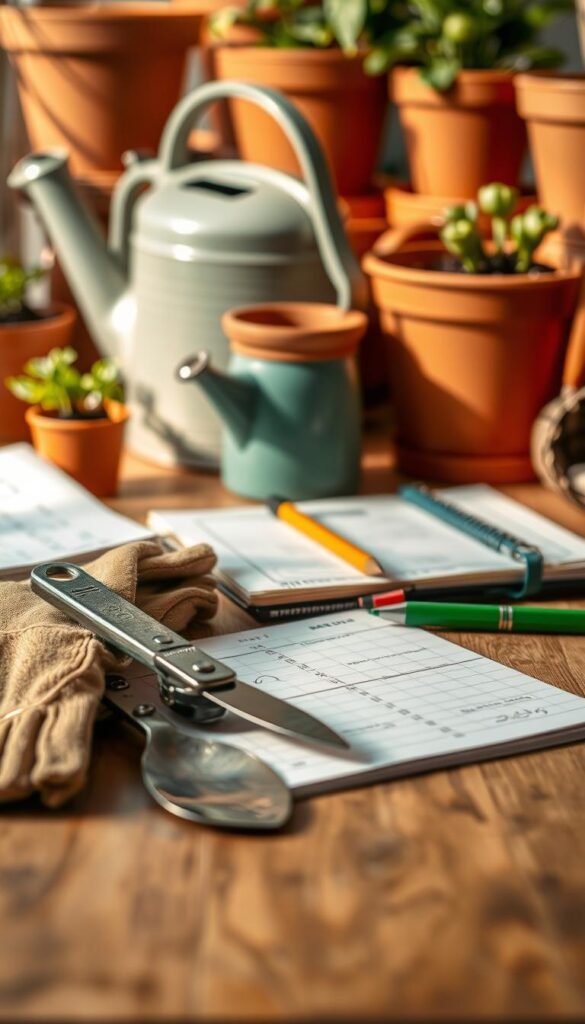
Transforming a compact outdoor spot starts with clarity—knowing exactly what you have and what you want. A well-planned layout turns limitations into opportunities, letting you grow food, unwind, or host friends without chaos. Let’s map your path to success.
Assessing Your Available Space
Grab a tape measure and notebook. Jot down your plot’s exact size, plus fixed features like fences or slopes. Next, track sunlight patterns for 2-3 days. You’ll spot microclimates: sunny corners for tomatoes, shaded zones for ferns.
| Sun Exposure | Soil Type | Best Uses |
|---|---|---|
| Full sun (6+ hours) | Well-draining | Herbs, peppers, flowers |
| Partial shade | Moist clay | Lettuce, hostas, mint |
| Full shade | Rich compost | Ferns, mushrooms |
Check soil texture and drainage. Sandy dirt needs more water. Clay holds moisture longer. Fix access points early—you don’t want to block pathways with oversized planters!
Defining Your Garden Goals
Ask: “What matters most here?” A salad bar? A reading nook? List your top 3 priorities. Urban gardener Marie Kondo suggests:
“Pair joy with practicality. If a feature doesn’t serve your vision, rethink it.”
Balance dreams with reality. Love roses but have minimal sun? Try dwarf varieties in pots. Sketch zones for different needs, keeping high-traffic areas open. Snap photos of your space—they’ll reveal hidden potential during planning.
Planning Your Small Garden Layout
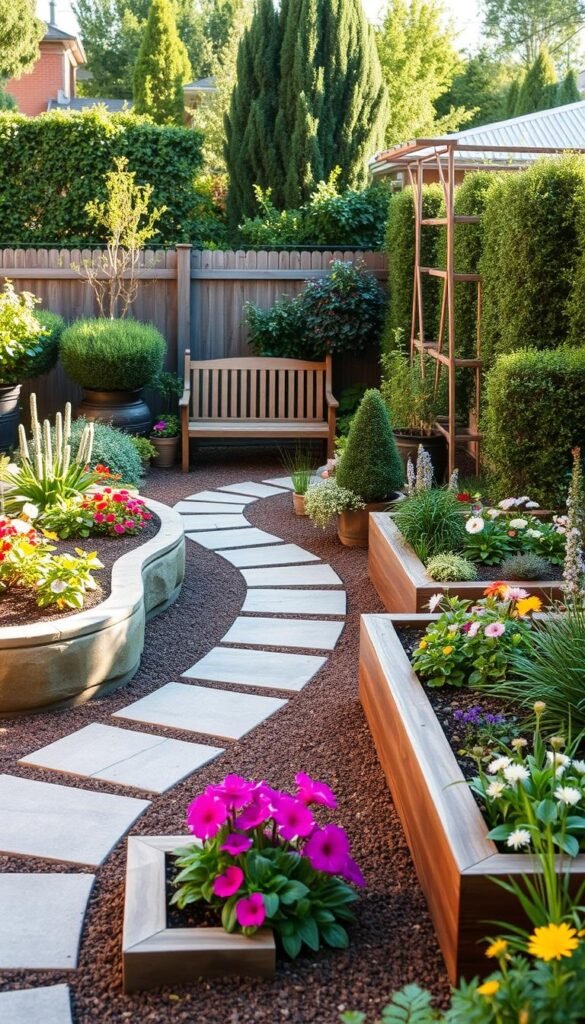
Your cozy outdoor area holds more potential than you might realize—if you know how to unlock it. Dividing your plot into purposeful zones lets you grow food, relax, and entertain without clutter. Start by sketching a rough map that balances your top priorities with smart space allocation.
Identifying Distinct Garden Zones
Think of your layout like a puzzle: each piece serves a role. A productive growing zone could host veggies in raised beds or pots. Nearby, a relaxation nook might feature foldable chairs tucked under a trellis. For dining, try a compact bistro set on raised decking to separate it visually from other areas.
Here’s how to make zones flow:
- Use low hedges or gravel paths to mark transitions
- Place tall plants at the back of growing areas
- Opt for multi-level planters to save ground space
Allocating Space Strategically
Traffic flow matters most in tight areas. Keep pathways at least 24 inches wide—enough for two people to pass comfortably. Pair vertical elements (like wall planters) with ground-level features to avoid crowding. If you’re working with a small backyard, prioritize dual-purpose items: a bench with storage or a table that folds against the fence.
| Zone | Ideal Size | Key Features |
|---|---|---|
| Growing | 30-50% | Raised beds, vertical planters |
| Relaxation | 20-30% | Compact seating, shade |
| Dining | 15-25% | Foldable furniture, lighting |
Remember: zones can overlap! Herbs in decorative pots double as table centerpieces, while string lights above seating add ambiance for evening gatherings.
Square Garden Design Techniques: Maximizing Efficiency and Beauty
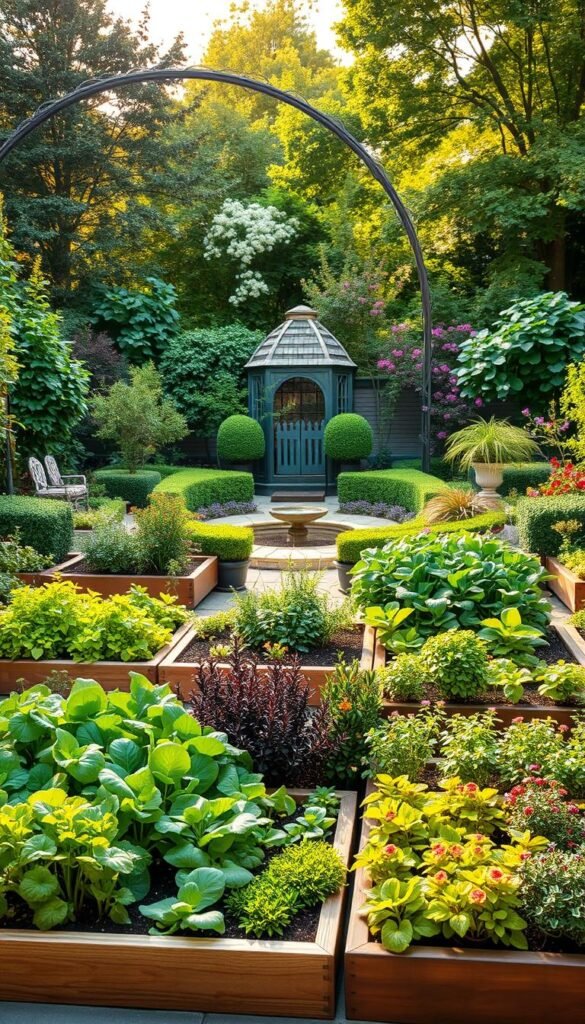
Transforming limited areas into vibrant retreats demands clever thinking. Focus on features that work twice as hard while enhancing your surroundings. Let’s dive into practical methods to optimize every inch without compromising charm.
Implementing Space-Saving Ideas
Measure twice, build once. Pathways wider than 24 inches? Trim them. Oversized storage sheds? Replace with vertical shelves or under-seat bins. A patio sized precisely for your table ensures no empty gaps. As urban planner Lena Chen notes:
“Tiny spaces thrive when every element earns its place.”
Use narrow planters along fences for herbs or flowers. Hang foldable chairs when not in use. These tweaks free up room for what matters—your favorite plants or a cozy fire pit.
Blending Functionality with Aesthetics
Why choose between pretty and practical? Trellises support climbing veggies while adding vertical interest. Decorative pots with drainage holes house herbs and serve as art. Try these dual-purpose upgrades:
- Bench seats with hidden storage
- Pathway stones spaced for easy mowing
- Wall-mounted lights that illuminate and deter pests
Pair textures like smooth stones with feathery grasses to elevate your garden’s visual appeal. Remember: a well-planned layout feels spacious even when every square foot works hard.
| Space-Smart Feature | Common Mistake | Fix |
|---|---|---|
| 18-inch pathways | 36-inch walkways | Use stepping stones |
| Stacked planters | Single-level beds | Add tiered shelves |
| Compact furniture | Oversized seating | Choose foldable designs |
Vertical Gardening for Compact Spaces
Short on ground space? Look up—your next garden bed might be on the wall. Vertical systems let you grow twice as much in the same footprint while keeping harvests tidy and within reach. Whether you’re working with a balcony or narrow side yard, upward growth offers fresh solutions.
Utilizing Trellises and Wall Planters
Start with sturdy supports. Metal grids handle heavy climbers like winter squash, while lightweight bamboo works for peas. For quick setups, try wall pockets filled with strawberries or trailing flowers. As urban farmer Diego Ramirez advises:
“Match your structure to your plants’ weight. A flimsy trellis topples tomatoes but perfect for sweet peas.”
Position climbing vegetables where they’ll thrive. Beans love south-facing walls, while leafy greens prefer shaded vertical planters. Check out small-space layouts that pair these systems with smart spacing.
| Support Type | Best For | Installation Tip |
|---|---|---|
| Wire mesh | Cucumbers, melons | Anchor into ground |
| Wood lattice | Flowering vines | Use rust-proof nails |
| PVC pipes | Herb towers | Drill drainage holes |
Maximizing Vertical Growing Areas
Train plants early. Gently tie tomato stems to stakes using soft cloth strips. For pole beans, wrap tendrils clockwise around poles. Rotate pots weekly so all sides get sun—this prevents lopsided growth.
Mix edible and decorative climbers. Scarlet runner beans add color while producing tasty pods. Need inspiration? Explore square-foot layouts that integrate vertical layers seamlessly.
Remember: your vertical space isn’t just for growing. Hang wind chimes or solar lights between planters to create a cozy, multi-level retreat that feeds both body and soul.
Container Gardening for Flexible Designs
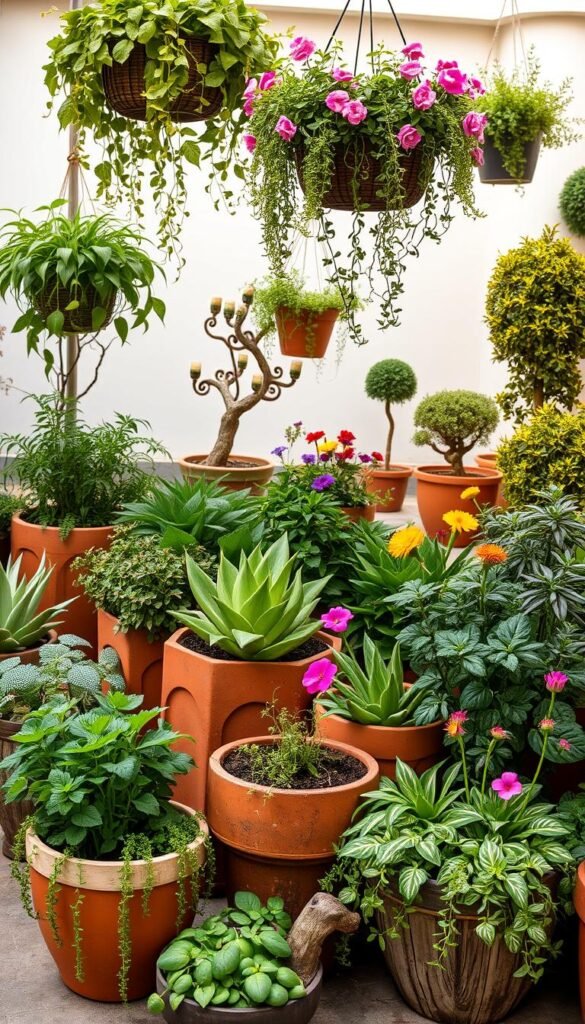
What if your plants could move to chase the sun? Containers let you rearrange your green space like puzzle pieces, adapting to light shifts and seasonal needs. This approach keeps roots happy and your layout fresh—no digging required.
Choosing the Right Containers for Your Plants
Size matters most. Carrots and tomatoes demand deep pots (12+ inches) for robust roots. Basil and thyme? Shallow 6-inch homes work perfectly. Material choice matters too:
| Container Type | Best For | Pro Tip |
|---|---|---|
| Lightweight plastic | Hanging shelves | Add perlite for drainage |
| Terracotta | Ground-level herbs | Water more frequently |
| Fiberglass | Balcony veggies | Use casters for mobility |
Gardening expert Nora Lee advises:
“Match your pot’s weight to its location. Top-heavy planters on shaky shelves spell disaster.”
Creating Mobile Planters to Optimize Sunlight
Wheels unlock new possibilities. Roll spinach into morning light, then shift it to shade by noon. Try these smart moves:
- Group three small planters on a rolling cart
- Use foldable fabric pots for easy storage
- Label containers with sun requirements
Check drainage holes monthly—clogs drown roots. Rotate pots weekly so all sides get equal light exposure. With mobile setups, your space evolves as quickly as your plants grow.
Raised Bed Strategies for Organized Planting
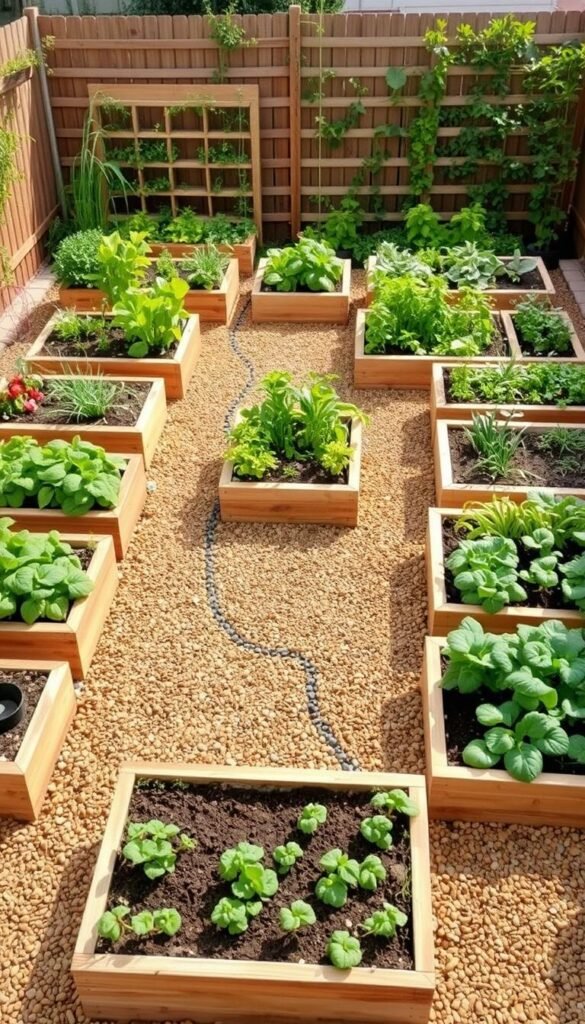
Who says small spaces can’t have big harvests? Raised beds turn cramped corners into thriving plant hubs by creating clear boundaries and better soil control. These structures let you grow more in less room while keeping weeds and pests at bay.
Designing L-Shaped and U-Shaped Beds
Wrap your growing areas around fences or walls using smart shapes. An L-shaped bed fits snugly into corners, while U-shaped designs create cozy nooks for herbs or flowers. Try a keyhole layout—a circular bed with a narrow entrance—to reach all plants without stepping on soil.
These setups work wonders for:
- Growing vine crops along outer edges
- Creating natural dividers between zones
- Maximizing sunlight exposure
Optimizing Bed Dimensions for Productivity
Keep beds no wider than 4 feet so you can reach the center easily. Height matters too—12-inch sides suit shallow roots like lettuce, while 18-inch depths accommodate carrots. Gardener Tom Walters suggests:
“Build your first bed 3 feet wide. You’ll quickly learn what works for your space and comfort.”
| Bed Height | Ideal Plants | Maintenance Tip |
|---|---|---|
| 6-8 inches | Herbs, flowers | Add mulch to retain moisture |
| 12-14 inches | Tomatoes, peppers | Install drip irrigation |
| 18+ inches | Root vegetables | Layer soil types |
Space plants using square foot gardening principles—group quick growers like radishes with slower ones like broccoli. This approach keeps your beds productive all season without overcrowding.
Multi-Functional Elements That Save Space
Why settle for single-use items when your garden furniture can multitask? Clever designs merge seating, storage, and growing areas into seamless features that make every inch count. This approach lets you host friends, store tools, and nurture plants—all without cluttering your outdoor retreat.
Dual-Purpose Seating and Storage Solutions
Storage benches with built-in planters are game-changers. Imagine hollow seats that open to hold trowels and gloves while hosting vibrant petunias or thyme on top. Space-saving furniture designer Eli Martinez notes:
“The best patio upgrades solve two problems at once. A bench isn’t just a seat—it’s your secret weapon against clutter.”
L-shaped corner units maximize tight areas beautifully. These wrap around fences or walls, creating cozy nooks where strawberries cascade from integrated planters. Use weather-resistant cedar or recycled plastic for longevity.
| Bench Type | Key Benefit | Ideal Plants |
|---|---|---|
| Perimeter Storage | Hides tools | Herbs, succulents |
| Corner Planter | Saves floor space | Trailing flowers |
| Foldable Deck | Adapts to events | Potted annuals |
Even decorative elements pull double duty. Ornamental arbors support climbing roses while casting afternoon shade over seating areas. Choose pieces that blend with your garden’s style—rustic trellises for cottage vibes or sleek metal frames for modern patios.
Strategic Plant Selection for Compact Areas
Ever feel like your plant choices are limited by your space? Think smaller—not less. The right varieties turn tight corners into productive powerhouses, delivering full-sized flavors without sprawling growth. Success starts with smart picks that thrive in confined settings.
Space-Smart Crops for Big Results
Dwarf varieties pack big yields into petite packages. Compact tomatoes like ‘Tiny Tim’ or ‘Patio Princess’ grow just 12-18 inches tall but burst with juicy fruits. Miniature eggplants and peppers follow suit, offering generous harvests from pots or narrow beds. As urban gardener Rachel Summers notes:
“Small-space gardening isn’t about sacrifice—it’s about finding plants that love living close.”
Herbs shine in tight spots. Basil, thyme, and oregano thrive in 6-inch pots, providing fresh flavors all season. Pair them with bush cucumbers that climb modest trellises instead of sprawling across your patio.
| Plant Type | Variety | Space Needed |
|---|---|---|
| Tomato | Patio Princess | 1 sq ft |
| Eggplant | Fairy Tale | 18″ diameter |
| Basil | Spicy Globe | 6″ pot |
Look for tags like “container-friendly” or “space-saving” at nurseries. These plants are bred to flourish in confined roots zones while resisting common stressors. Rotate pots weekly so all sides get equal sun exposure—your greens will reward you with balanced growth.
Layered Planting Designs: Creating Depth and Interest
Ever wish your small plot looked bigger without expanding? Layered planting tricks the eye by stacking greenery from soil to sky. This approach combines plants of varying heights to create natural depth while optimizing every inch of your growing area.
From Ground Covers to Taller Specimens
Start with creeping thyme or ajuga hugging the ground—these living carpets suppress weeds while adding texture. Behind them, mid-height salvias or dwarf dahlias create a colorful middle layer. Tall feather reed grass or slender hydrangeas anchor the back, drawing the gaze upward.
| Layer | Height Range | Top Picks |
|---|---|---|
| Ground | 2-6 inches | Sedum, Irish moss |
| Mid-Level | 12-24 inches | Marigolds, kale |
| Tall | 3-6 feet | Sunflowers, bamboo |
Landscape designer Clara Nguyen suggests:
“Vary leaf shapes within layers—pair spiky yucca with round hosta leaves for dynamic contrast.”
Using Succession Planting for Continuous Harvests
Keep your space productive year-round by timing plantings like a pro. Sow quick-growing radishes in early spring, then replace them with heat-loving peppers. As autumn nears, swap spent tomato plants for cold-hardy spinach.
Follow this seasonal rotation guide:
- Spring: Peas → Summer: Bush beans → Fall: Arugula
- Early tomatoes → Late-season carrots
- Cool-weather lettuce → Warm-weather basil
Pair this strategy with a seasonal care schedule to maintain soil health between crops. You’ll enjoy fresh harvests while keeping your garden visually engaging through multiple seasons.
Smart Water Management Techniques
Water is your secret weapon for creating a thriving outdoor area without waste. Start with drip irrigation systems—they deliver hydration directly to roots, cutting evaporation by up to 60%. Pair them with moisture sensors that alert you when plants truly need a drink.
Rain barrels transform free rainfall into a resource. Place them under downspouts, then use collected water for potted herbs or window boxes. Add a mesh filter to keep debris out and attach a spigot for easy access. As horticulturist Maya Patel advises: “Treat rainwater like liquid gold—it’s gentler on plants than treated tap water.”
Mulch does double duty by locking in moisture and suppressing weeds. Try straw for veggie beds or cocoa hulls around ornamentals for a sweet scent. For tight spaces, smart watering beats guesswork—set timers to run during cooler mornings when absorption peaks.
Your green space thrives when every drop counts. With these strategies, you’ll nurture lush growth while conserving resources—proving that small-scale care creates big environmental wins.

